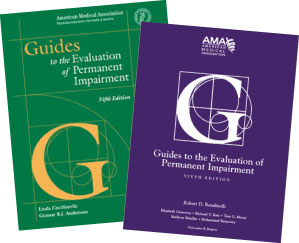The newest edition of AMA guides to the evaluation of Permanent Impairment (the Guides) was released December 27, 2007. This document is currently the leading source in the world for determining impairment due to injury or illness for many state, national and international associations, California and the ICA being a couple of them. In addition, this document continues its history as being a very chiropractic-friendly text and, therefore, becomes an essential resource for the chiropractic physician in a medico-legal environment.
The chapter of particular importance to the chiropractor who examines and treats worker’s compensation (WC) and cervical acceleration/deceleration (CAD) patients is Chapter 17, the spine chapter. The newest edition stresses the relationship between structure and function with the focus being on accurate objective reporting that will make the rating process more consistent between examiners.

The Guides have utilized the best evidence that was available to change and enhance the impairments and, in doing so, have added and deleted certain aspects of the 5th edition. Some of the criticisms of the 5th edition were: 1) There was no evidence-based rating system that enabled the rater a valid, reliable and unbiased method of determining a rating, 2) the impairment rating that was calculated did not accurately reflect the individuals loss of function, 3) the numerical ratings that were calculated were more a “legal fiction than medical reality. Because of these criticisms, and why the Guides are the leading source of impairment rating, there have been a number of significant changes, particularly to chapter 17, which should cause the doctor of chiropractic to take notice.
Some of those changes attempt to create a paradigm shift that assumes the contemporary model of disablement by making the rating system more simplified, functionally based and consistent. With these changes in mind, the Guides envisioned five new axioms and they are:
1) The Guides adopts the terminology and conceptual framework of disablement as put forward by the International Classification of Functioning, Disability, and Health (ICF).
2) The Guides becomes more diagnosis based with these diagnoses being evidence-based when possible.
3) Simplicity, ease of application, and following precedent, where applicable, are given high priority, with the goal of optimizing interrater reliability and intrarater reliability.
4) Rating percentages derived according to the Guides are functionally based, to the fullest practical extent possible.
5) The Guides stresses conceptual and methodological congruity within and between organ system ratings.
The Guides utilize an expanded version of the diagnosis related estimates (DRE) categories and named them the diagnosis based impairments (DBI). The diagnosis categories have stayed the same but the authors have allowed each category to be expanded to enable the individual’s functional history, physical examination and clinical studies to adjust the whole person impairment (WPI) up or down.
In the next few articles I will break down the Guides as much as possible within the limited amount of copy space to allow the reader to learn how they work and how much more accurate the impairment rating process has become. The chiropractors who treat a worker’s compensation or whiplash patient needs to learn the 6th edition of the Guides and become the leaders in their respective communities on impairments to allow for fair and just treatment and jury awards.
Dr. Whynot is in full time private practice in Johnson City, Tennessee, since 2000. He graduated from Logan College of Chiropractic after completing his undergraduate degree at Dalhousie University in Halifax, Nova Scotia, Canada. Dr Whynot gives license renewal seminars on Evidence-based Chiropractic topics including impairment rating and personal injury case management. He also gives license renewal lectures to the medical community through East Tennessee State University College of Medicine continuing education department. For questions regarding evidence based practice procedures, email [email protected]. For more information about Dr. Whynot’s Evidence-Based Chiropractic Seminars go to www.ebcseminars.com.
